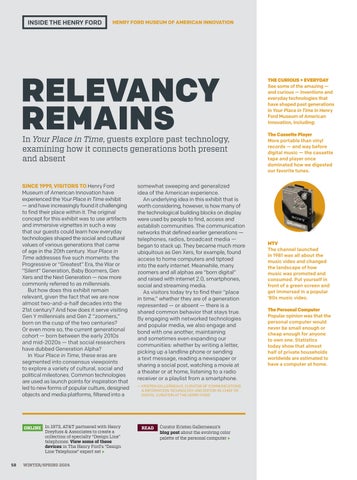INSIDE THE HENRY FORD
HENRY FORD MUSEUM OF AMERICAN INNOVATION
RELEVANCY REMAINS
In Your Place in Time, guests explore past technology, examining how it connects generations both present and absent
SINCE 1999, VISITORS TO Henry Ford Museum of American Innovation have experienced the Your Place in Time exhibit — and have increasingly found it challenging to find their place within it. The original concept for this exhibit was to use artifacts and immersive vignettes in such a way that our guests could learn how everyday technologies shaped the social and cultural values of various generations that came of age in the 20th century. Your Place in Time addresses five such moments: the Progressive or “Greatest” Era, the War or “Silent” Generation, Baby Boomers, Gen Xers and the Next Generation — now more commonly referred to as millennials. But how does this exhibit remain relevant, given the fact that we are now almost two-and-a-half decades into the 21st century? And how does it serve visiting Gen Y millennials and Gen Z “zoomers,” born on the cusp of the two centuries? Or even more so, the current generational cohort — born between the early 2010s and mid-2020s — that social researchers have dubbed Generation Alpha? In Your Place in Time, these eras are segmented into consensus viewpoints to explore a variety of cultural, social and political milestones. Common technologies are used as launch points for inspiration that led to new forms of popular culture, designed objects and media platforms, filtered into a
ONLINE In 1973, AT&T partnered with Henry Dreyfuss & Associates to create a collection of specialty “Design Line” telephones. View some of these devices in The Henry Ford’s “Design Line Telephone” expert setc 58
WINTER/SPRING 2024
somewhat sweeping and generalized idea of the American experience. An underlying idea in this exhibit that is worth considering, however, is how many of the technological building blocks on display were used by people to find, access and establish communities. The communication networks that defined earlier generations — telephones, radios, broadcast media — began to stack up. They became much more ubiquitous as Gen Xers, for example, found access to home computers and tiptoed into the early internet. Meanwhile, many zoomers and all alphas are “born digital” and raised with internet 2.0, smartphones, social and streaming media. As visitors today try to find their “place in time,” whether they are of a generation represented — or absent — there is a shared common behavior that stays true. By engaging with networked technologies and popular media, we also engage and bond with one another, maintaining and sometimes even expanding our communities: whether by writing a letter, picking up a landline phone or sending a text message, reading a newspaper or sharing a social post, watching a movie at a theater or at home, listening to a radio receiver or a playlist from a smartphone. — KRISTEN GALLERNEAUX, CURATOR OF COMMUNICATIONS & INFORMATION TECHNOLOGY AND EDITOR-IN-CHIEF OF DIGITAL CURATION AT THE HENRY FORD
READ
Curator Kristen Gallerneaux’s blog post about the evolving color palette of the personal computerc
THE CURIOUS + EVERYDAY See some of the amazing — and curious — inventions and everyday technologies that have shaped past generations in Your Place in Time in Henry Ford Museum of American Innovation, including: The Cassette Player More portable than vinyl records — and way before digital music — the cassette tape and player once dominated how we digested our favorite tunes.
MTV The channel launched in 1981 was all about the music video and changed the landscape of how music was promoted and consumed. Put yourself in front of a green screen and get immersed in a popular ‘80s music video. The Personal Computer Popular opinion was that the personal computer would never be small enough or cheap enough for anyone to own one. Statistics today show that almost half of private households worldwide are estimated to have a computer at home.
